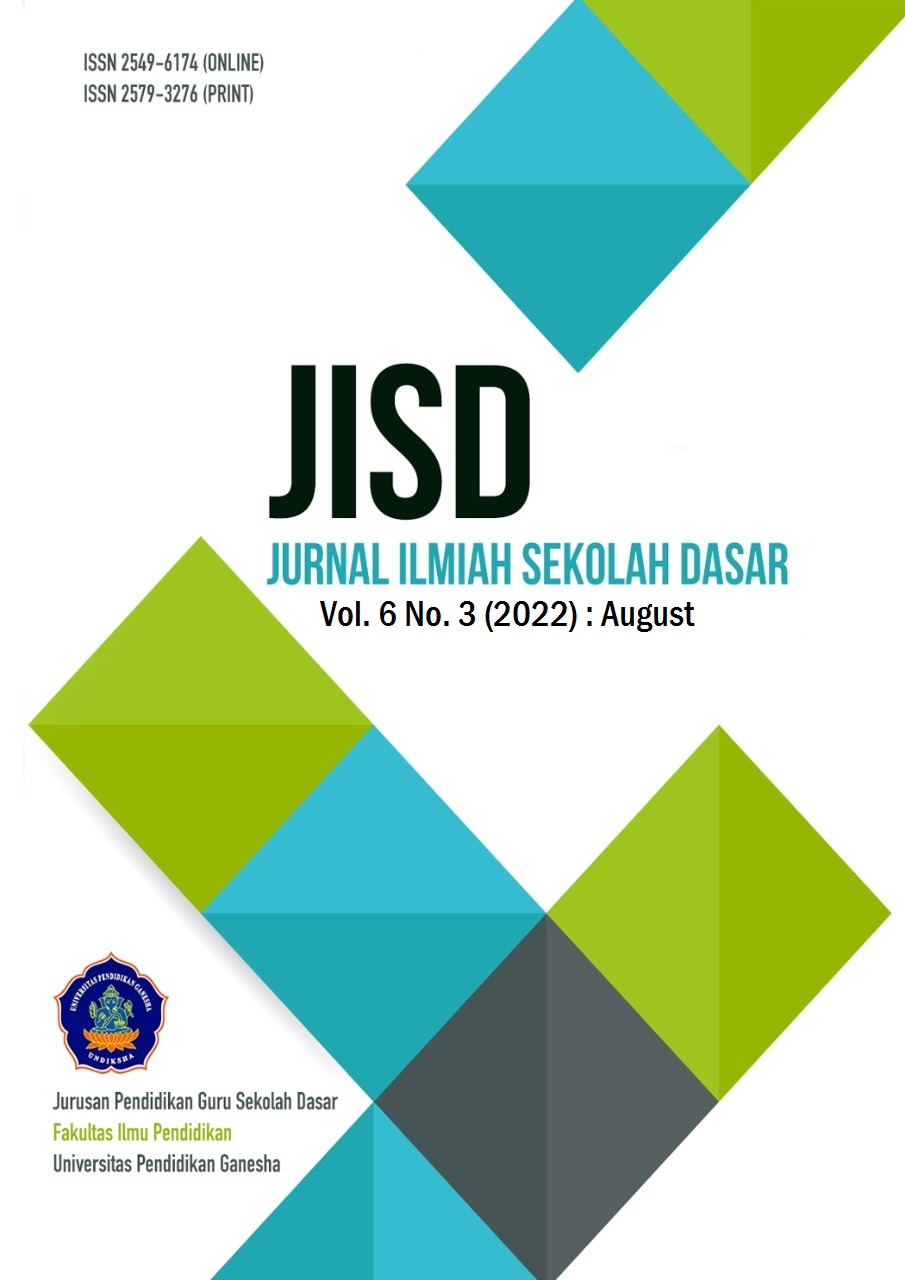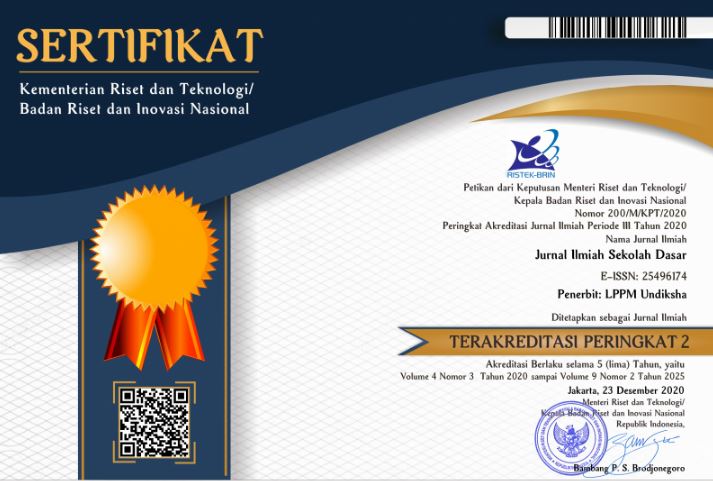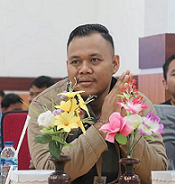Elementary Clarification Analysis (Critical Thinking Skill) Elementary School Students Based on Grade and Learning Method
DOI:
https://doi.org/10.23887/jisd.v6i3.47366Keywords:
Elementary Clarification, Critical Thinking, SAINSAbstract
It is important for students to have critical thinking skills, but data regarding the critical thinking skills of elementary school students are still lacking. The purpose of the study was to analyze elementary clarification skills on critical thinking skills of elementary school students in learning science. This research is based on grade level and teaching method. This research is a survey research on 226 fourth to sixth grade students from seven elementary schools. The research instrument used a questionnaire. The data analysis technique used descriptive quantitative analysis and multiple linear regression test. The results showed that elementary school students were able to apply elementary clarification critical thinking skills in science learning, but students' ability to focus on a problem still needed to be improved. Based on the grade of the students, it is known that the critical thinking skills of elementary clarification students in higher grades get better grades. The conclusion that the learning model had an effect on critical thinking skills in elementary clarification. The learning method to train critical thinking (problem-based) is able to improve students' critical thinking skills.
References
Álvarez-Huerta, P., Muela, A., & Larrea, I. (2022). Disposition toward critical thinking and creative confidence beliefs in higher education students: The mediating role of openness to diversity and challenge. Thinking Skills and Creativity, 43(January). https://doi.org/10.1016/j.tsc.2022.101003. DOI: https://doi.org/10.1016/j.tsc.2022.101003
Anderson, L.W., & Krathwohl, D. . (2010). Kerangka Landasan untuk Pembelajaran, Pengajaran dan Asesmen : Revisi Taksonomi Pendidikan Bloom. Pustaka Pelajar.
Antara, I. G. W. S., & Dewantara, K. A. K. (2022). E-Scrapbook: The Needs of HOTS Oriented Digital Learning Media in Elementary Schools. Journal for Lesson and Learning Studies, 5(1), 71–76. https://doi.org/10.23887/jlls.v5i1.48533. DOI: https://doi.org/10.23887/jlls.v5i1.48533
As’ari, A. R. (2014). Ideas For Developing Critical Thinking. International Seminar on Addressing Higher Order Thinking: Critical Thinking Issues in Primary Education, April 2014, 1–13. https://doi.org/10.13140/2.1.4534.9921.
Barka, L. T., Suprapto, P. K., & Metylani, V. (2020). The Relationship Level of Critical Thinking Ability and Student Learning Outcomes in Invertebrata Materials. Bioeducational Journal, 4(2), 58–65. https://doi.org/10.24036/bioedu.v4i2.256.
Budiman, A., & Jailani, J. (2014). Pengembangan Instrumen Asesmen Higher Order Thinking Skill (Hots) Pada Mata Pelajaran Matematika SMP Kelas Viii Semester 1. Jurnal Riset Pendidikan Matematika, 1(2), 139. https://doi.org/10.21831/jrpm.v1i2.2671. DOI: https://doi.org/10.21831/jrpm.v1i2.2671
Candra, & Retnawati, H. (2020). A meta-analysis of constructivism learning implementation towards the learning outcomes on civic education lesson. International Journal of Instruction, 13(2), 835–846. https://doi.org/10.29333/iji.2020.13256a. DOI: https://doi.org/10.29333/iji.2020.13256a
Changwong, K., Sukkamart, A., & Sisan, B. (2018). Critical thinking skill development: Analysis of a new learning management model for Thai high schools. Journal of International Studies, 11(2), 37–48. https://doi.org/10.14254/2071-8330.2018/11-2/3. DOI: https://doi.org/10.14254/2071-8330.2018/11-2/3
Chukwuyenum, A. N. (2013). Impact of Critical thinking on Performance in Mathematics among Senior Secondary School Students in Lagos State. IOSR Journal of Research & Method in Education (IOSRJRME), 3(5), 18–25. https://doi.org/10.9790/7388-0351825. DOI: https://doi.org/10.9790/7388-0351825
Creswell, J. H., & Creswell, J. D. (2018). Research Design: Qualitative, Quantitative, and Mixed Methods Approaches (Fifth Edition). Thousand Oaks, CA: SAGE.
Dwyer, C. P., & Walsh, A. (2020). An exploratory quantitative case study of critical thinking development through adult distance learning. Educational Technology Research and Development, 68(1), 17–35. https://doi.org/10.1007/s11423-019-09659-2. DOI: https://doi.org/10.1007/s11423-019-09659-2
Eileen Gambrill, L. G. (2017). Critical Thinking for Helping Professionals: A Skills-Based Workbook. Oxford University Press.
Ekici, D. I. (2017). The effects of online communities of practice on pre-service teachers’ critical thinking dispositions. Eurasia Journal of Mathematics, Science and Technology Education, 13(7), 3801–3827. https://doi.org/10.12973/eurasia.2017.00759a. DOI: https://doi.org/10.12973/eurasia.2017.00759a
Ennis, R. H. (1985). A Logical Basis for Measuring Critical Thinking Skills. Educational Leadership, 43, 44–48. https://jgregorymcverry.com/readings/ennis1985assessingcriticalthinking.pdf.
Erikson, M. G., & Erikson, M. (2019). Learning outcomes and critical thinking–good intentions in conflict. Studies in Higher Education, 44(12), 2293–2303. https://doi.org/10.1080/03075079.2018.1486813. DOI: https://doi.org/10.1080/03075079.2018.1486813
Heidari, M., & Ebrahimi, P. (2016). Examining the relationship between critical-thinking skills and decision-making ability of emergency medicine students. Indian Journal of Critical Care Medicine, 20(10), 581–586. https://doi.org/10.4103/0972-5229.192045. DOI: https://doi.org/10.4103/0972-5229.192045
Helsdingen, A., & Merrienboer, J. J. G. Van. (2010). The Effects of Critical Thinking Instruction on Training Complex Decision Making The Effects of Critical Thinking Instruction on Training Complex Decision Making. The Journal of the Human Factors and Ergonomics Society, May 2014, 1–24. https://doi.org/10.1177/0018720810377069. DOI: https://doi.org/10.1177/0018720810377069
Hu, W., Jia, X., Plucker, J. A., & Shan, X. (2016). Effects of a Critical Thinking Skills Program on the Learning Motivation of Primary School Students. Roeper Review, 38(2), 70–83. https://doi.org/10.1080/02783193.2016.1150374. DOI: https://doi.org/10.1080/02783193.2016.1150374
Huang, M., Tu, H., Wang, W., Chen, J., Yu, Y., & Chou, C. (2017). Effects of Cooperative Learning and Concept Mapping Intervention on Critical Thinking and Basketball Skills in Elementary School. Thinking Skills and Creativity. https://doi.org/10.1016/j.tsc.2017.01.002. DOI: https://doi.org/10.1016/j.tsc.2017.01.002
Ilhamdi, M. L., Novita, D., & Rosyidah, A. N. K. (2020). Pengaruh Model Pembelajaran Inkuiri Terbimbing Terhadap Kemampuan Berpikir Kritis IPA SD. Jurnal KONTEKSTUAL, 1(2), 49–57. https://doi.org/10.46772/kontekstual.v1i02.162. DOI: https://doi.org/10.46772/kontekstual.v1i02.162
Khasanah, A. N., Sajidan, S., & Widoretno, S. (2017). Effectiveness of critical thinking indicator-based module in empowering student’s learning outcome in respiratory system study material. Jurnal Pendidikan IPA Indonesia, 6(1), 187–195. https://doi.org/10.15294/jpii.v6i1.8490. DOI: https://doi.org/10.15294/jpii.v6i1.8490
Kirmizi, F. S., Saygi, C., & Yurdakal, I. H. (2015). Determine the Relationship Between the Disposition of Critical Thinking and the Perception About Problem Solving Skills. Procedia - Social and Behavioral Sciences, 191, 657–661. https://doi.org/10.1016/j.sbspro.2015.04.719. DOI: https://doi.org/10.1016/j.sbspro.2015.04.719
Kırbaşlar, M., & Özsoy-Güneş, Z. (2015). The Effect of Critical Thinking Disposition on Entrepreneurship Levels: A Study on Future Teachers. Procedia - Social and Behavioral Sciences, 174, 199–207. https://doi.org/10.1016/j.sbspro.2015.01.647. DOI: https://doi.org/10.1016/j.sbspro.2015.01.647
Kumala, F. N., Firdayani, K., & Hudha, M. N. (2018). Keterampilan Berpikir Kritis IPA Siswa SD : Brain Based Learning ( BBL ) dan Problem Based Learning ( PBL ). Jurnal Inspirasi Pendidikan, 8(2), 53–59. https://doi.org/10.21067/jip.v8i2.2641. DOI: https://doi.org/10.21067/jip.v8i2.2641
Li, L. Y., Fan, C. Y., Huang, D. W., & Chen, G. D. (2013). The effects of the E-book system with the reading guidance and the annotation map on the reading performance of college students. Educational Technology and Society, 17(1), 320–331. https://www.jstor.org/stable/jeductechsoci.17.1.320.
Mahapoonyanont, N. (2012). The Causal Model of Some Factors Affecting Critical Thinking Abilities. Procedia - Social and Behavioral Sciences, 46, 146–150. https://doi.org/10.1016/j.sbspro.2012.05.084. DOI: https://doi.org/10.1016/j.sbspro.2012.05.084
Mulyanto, H., Gunarhadi, G., & Indriayu, M. (2018). The Effect of Problem Based Learning Model on Student Mathematics Learning Outcomes Viewed from Critical Thinking Skills. International Journal of Educational Research Review, 3(2), 37–45. https://doi.org/10.24331/ijere.408454. DOI: https://doi.org/10.24331/ijere.408454
Nappi, J. S. (2017). The Impact of Teacher Efficacy and Beliefs on Writing Instruction. International Journal for Professional Educators, 84(1), 17. https://www.dkg.is/static/files/skjol_landsamband/bulletin_grein_jona.pdf#page=17.
Nosich, M. (2016). Critical thinking and interdisciplinary critical thinking guide. Ani Piblishing.
Palavan, Ö. (2020). The effect of critical thinking education on the critical thinking skills and the critical thinking dispositions of preservice teachers. Educational Research and Reviews, 15(10), 606–627. https://doi.org/10.5897/err2020.4035. DOI: https://doi.org/10.5897/ERR2020.4035
Priawasana, E., Degeng, I. N. S., Utaya, S., & Kuswandi, D. (2020). An experimental analysis on the impact of elaboration learning on learning achievement and critical thinking. Universal Journal of Educational Research, 8(7), 3274–3279. https://doi.org/10.13189/ujer.2020.080757. DOI: https://doi.org/10.13189/ujer.2020.080757
Purwanita, Y., Riyanto, Y., & Suyanto, T. (2019). The Influence of Multimedia Assisted Inquiry Learning Methods on My Heroes Theme of Critical Thinking Skills and Learning Outcomes of Class IV Students ofElementary School. International Journal of Scientific and Research Publications (IJSRP), 9(7), p9169. https://doi.org/10.29322/ijsrp.9.07.2019.p9169. DOI: https://doi.org/10.29322/IJSRP.9.07.2019.p9169
Rahman, S. A., & Manaf, N. F. A. (2017). A Critical Analysis of Bloom’s Taxonomy in Teaching Creative and Critical Thinking Skills in Malaysia through English Literature. English Language Teaching, 10(9), 245. https://doi.org/10.5539/elt.v10n9p245. DOI: https://doi.org/10.5539/elt.v10n9p245
Santoso, T., Yuanita, L., & Erman, E. (2018). The role of student’s critical asking question in developing student’s critical thinking skills. Journal of Physics: Conference Series, 953(1), 0–6. https://doi.org/10.1088/1742-6596/953/1/012042. DOI: https://doi.org/10.1088/1742-6596/953/1/012042
Shaleha, P. R., Kumala, F. N., & Denna, D. (2019). Keterampilan Berpikir Kritis: Model Brain-Based Learning Dan Dan Model Whole Brain Teaching. Jurnal Bidang Pendidikan Dasar, 3(2), 9–14. https://doi.org/10.21067/jbpd.v3i2.3356. DOI: https://doi.org/10.21067/jbpd.v3i2.3356
Siburian, J., Ibrohim, A. D. C., & Saptasari, M. (2019). The Correlation Between Critical and Creative Thinking Skills on Cognitive Learning Results. Eurasian Journal of Educational Research, 81, 99–114. https://doi.org/10.14689/ejer.2019.81.6. DOI: https://doi.org/10.14689/ejer.2019.81.6
Spector, J. M., & Ma, S. (2019). Inquiry and critical thinking skills for the next generation: from artificial intelligence back to human intelligence. Smart Learning Environments, 6(1). https://doi.org/10.1186/s40561-019-0088-z. DOI: https://doi.org/10.1186/s40561-019-0088-z
Sriarunrasmee, J., Suwannatthachote, P., & Dachakupt, P. (2015). Virtual Field Trips with Inquiry learning and Critical Thinking Process: A Learning Model to Enhance Students’ Science Learning Outcomes. Procedia - Social and Behavioral Sciences, 197(February), 1721–1726. https://doi.org/10.1016/j.sbspro.2015.07.226. DOI: https://doi.org/10.1016/j.sbspro.2015.07.226
Suryanti, Arifin, I. S., & Baginda, U. (2018). The application of inquiry learning to train critical thinking skills on light material of primary school students. IOPScience: Journal of Physics: Conference Series, 11(8), 1–7. https://doi.org/10.1088/1742-6596/1108/1/012128. DOI: https://doi.org/10.1088/1742-6596/1108/1/012128
Tang, T., Vezzani, V., & Eriksson, V. (2020). Developing critical thinking, collective creativity skills and problem solving through playful design jams. Thinking Skills and Creativity, 37(May), 100696. https://doi.org/10.1016/j.tsc.2020.100696. DOI: https://doi.org/10.1016/j.tsc.2020.100696
Yaldiz, N., & Bailey, M. (2019). The Effect of Critical Thinking on Making the Right Decisions in the New Venture Process. Procedia Computer Science, 158, 281–286. https://doi.org/10.1016/j.procs.2019.09.053. DOI: https://doi.org/10.1016/j.procs.2019.09.053
Yazar Soyadı, B. B. (2015). Creative and Critical Thinking Skills in Problem-based Learning Environments. Journal of Gifted Education and Creativity, 2(2), 71–71. https://doi.org/10.18200/jgedc.2015214253. DOI: https://doi.org/10.18200/JGEDC.2015214253
Yerimadesi, Y., Bayharti, B., Azizah, A., Lufri, L., Andromeda, A., & Guspatni, G. (2019). Effectiveness of acid-base modules based on guided discovery learning for increasing critical thinking skills and learning outcomes of senior high school student. Journal of Physics: Conference Series, 1185(1), 0–6. https://doi.org/10.1088/1742-6596/1185/1/012151. DOI: https://doi.org/10.1088/1742-6596/1185/1/012151
Young, M., & Lee Warren, D. (2011). Encouraging the development of critical thinking skills in the introductory accounting courses using the challenge problem approach. Issues in Accounting Education, 26(4), 859–881. https://doi.org/10.2308/iace-50065. DOI: https://doi.org/10.2308/iace-50065
Downloads
Published
How to Cite
Issue
Section
License
Copyright (c) 2022 Farida Nur Kumala, Arnelia Dwi Yasa, Rio Dandy Samudra

This work is licensed under a Creative Commons Attribution-ShareAlike 4.0 International License.
Authors who publish with the Journal Ilmiah Sekolah Dasar agree to the following terms:
- Authors retain copyright and grant the journal the right of first publication with the work simultaneously licensed under a Creative Commons Attribution License (CC BY-SA 4.0) that allows others to share the work with an acknowledgment of the work's authorship and initial publication in this journal.
- Authors are able to enter into separate, additional contractual arrangements for the non-exclusive distribution of the journal's published version of the work (e.g., post it to an institutional repository or publish it in a book), with an acknowledgment of its initial publication in this journal.
- Authors are permitted and encouraged to post their work online (e.g., in institutional repositories or on their website) prior to and during the submission process, as it can lead to productive exchanges, as well as earlier and greater citation of published work. (See The Effect of Open Access)










